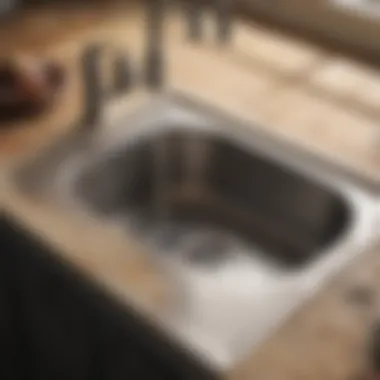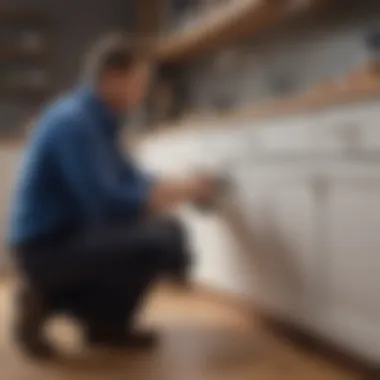Understanding Water Backup Issues in Your Kitchen Sink


Intro
Water backing up into the kitchen sink is not just an inconvenience; it can signal deeper plumbing problems. Understanding this issue is essential for homeowners who want to maintain the functionality and hygiene of their kitchens. A kitchen sink that does not drain properly can lead to unsanitary conditions, increased repair costs, and disruptions to daily routines.
In this article, we will address the common causes of water backup, outline preventive measures, and propose effective solutions. This guide aims to enhance your comprehension of plumbing systems, identify signs of blockages, and assist in deciding when to engage a professional.
Proper maintenance of kitchen plumbing can help in minimizing issues related to water backup. This guide serves as a comprehensive resource for real estate enthusiasts, home improvement aficionados, and anyone seeking to enhance their understanding of home maintenance.
We will delve into various topics related to kitchen sink plumbing and provide insights that help you address this common yet critical kitchen issue.
Preamble to the Problem
Dealing with water backing up into the kitchen sink is a concern many homeowners face. The importance of this issue is not just in the inconvenience it brings, but also in the potential damage it can cause to your plumbing system and your kitchen environment. A simple blockage or malfunction can escalate into a significant problem if not addressed promptly.
Understanding the concept of water backup involves recognizing the basic principles of how drainage systems function. An effective drainage system is designed to channel waste water out of the kitchen efficiently. However, when this system fails, it can lead to water accumulation in places where it should not be, like your kitchen sink. This can lead to a domino effect of complications, including unpleasant odors and potential structural damage.
In this article, we will explore the nuances of water backup, including its common causes and how to recognize the symptoms. We will also discuss essential prevention strategies that can protect your kitchen and plumbing system from future issues. By understanding these factors, you will be better equipped to maintain a functional and hygienic kitchen environment.
Definition of Water Backup
Water backup occurs when wastewater flows back into the system it was supposed to exit. This can happen in various fixtures, but the kitchen sink is one of the most affected areas. Several factors can contribute to this phenomenon, including blockages in drainage pipes or issues within the sewer system. When the normal flow of water is interrupted, it can cause water to rise and possibly overflow from sinks and other fixtures.
Why It Matters
Understanding why water backup matters is crucial for several reasons. Firstly, unresolved water backup can lead to serious plumbing issues, resulting in costly repairs. Ignoring early signs like slow drainage or gurgling noises might allow a minor blockage to escalate into a more severe situation.
Moreover, water backup can create an unhygienic environment in your kitchen, serving as a breeding ground for bacteria and mold. This can pose health risks to you and your family. Therefore, recognizing and addressing water backup promptly is vital to preserve the integrity of your kitchen space and ensure the health and safety of its users.
"Proactive maintenance and awareness are keys to preventing water backup issues in the kitchen."
Common Causes of Water Backup
Understanding the common causes of water backup is essential for homeowners to effectively manage and prevent this issue. Each cause can indicate a specific problem within the plumbing systems that may not only affect the kitchen sink but also other plumbing fixtures within the home. Recognizing these causes allows for timely interventions, minimizes damage, and can save homeowners from more costly repairs down the line.
Clogged Drainage System
A primary cause of water backup is a clogged drainage system. Over time, debris such as food particles, grease, and soap scum can accumulate in the pipes. This buildup restricts the flow of water and can result in water pooling in the sink. Regularly cleaning the drain and avoiding disposal of unsuitable items can significantly reduce the risk of clogs.
To mitigate this risk:
- Use hot water to flush drains regularly.
- Consider enzyme-based cleaners that break down organic material.
- Do not dispose of grease or fibrous food waste in the sink.
Improper Slope in Drainage Pipes
Another cause for water backup involves improper sloping of drainage pipes. Pipes should be installed with a slight angle to facilitate drainage. If the slope is incorrect, water can accumulate in low spots, leading to backups. This issue may be due to installation errors or subsequent ground settling.


A qualified plumber can assess the drainage slope and make adjustments if necessary. Proper installation initially can save money and headaches later on.
Overflow from Related Fixtures
Water backing up may also result from overflow from related fixtures, such as dishwashers or washing machines. If these appliances are not draining properly, water can flow back into the kitchen sink. Commonly, a blockage in the appliance's drain line or a malfunctioning pump could be at fault.
Homeowners should regularly check connections and hoses for leaks or kinks, ensuring a clear pathway for the water.
Tree Roots Interfering with Pipes
Tree roots can become invasive and interfere with sewer pipes, causing blockages that lead to water backup. Roots can penetrate pipes through small cracks or joints, expanding over time and creating obstructions. This issue is more prevalent in older homes with aging sewer systems.
To prevent this:
- Regularly inspect sewer lines for integrity.
- Consider using root barriers if large trees are nearby.
Damaged Sewer Lines
Damaged or collapsed sewer lines are a serious concern, leading to significant backups. Such damage can stem from age, ground pressure, or environmental factors. Beyond simple clogs, issues with the sewage line require immediate attention.
Symptoms to watch for include:
- Persistent drainage issues in multiple fixtures.
- Unusual odors coming from drains.
- Water pooling in areas away from the sink.
In cases of suspected sewer line damage, contacting a professional plumber is critical to assess the situation and decide the best course of action.
Identifying the Symptoms of Water Backup
Identifying the symptoms of water backup is critical for any homeowner. Understanding these symptoms can lead to early intervention, avoiding more extensive damage and costly repairs. Water backups can disrupt daily activities and deteriorate the kitchen environment. Recognizing the warning signs allows for timely actions, potentially preventing emergency situations.
Slow Drainage
One of the most telling signs of water backup in the kitchen sink is slow drainage. When water takes significantly longer to go down compared to usual, it indicates some form of blockage in the drainage system. This can stem from several factors, such as debris accumulation or food particles stuck in the pipes. Addressing slow drainage is crucial; ignoring this symptom may lead to a complete blockage in the future. Homeowners should consider regularly cleaning their drains to maintain optimal flow.
Gurgling Noises
Another indicator of potential water backup is gurgling noises emanating from the sink or drainage path. This sound often suggests that air is trapped in the plumbing system, leading to irregular water flow. Gurgling can occur when the pipe is partially obstructed or when other fixtures in the home, such as toilets, are affecting the drainage. Individuals should pay attention to these noises as they may require a closer examination of their plumbing. Quick action may resolve the issue before it escalates.
Unpleasant Odors
Unpleasant odors coming from the kitchen sink can be a clear sign of water backup. Stagnant water in a blocked pipe often breeds bacteria, leading to foul smells. This symptom not only indicates an underlying issue but also poses risks to hygiene and health. Homeowners should not dismiss odors as a simple inconvenience; instead, they should investigate the source promptly. Possible solutions may involve cleaning the drain or using natural products to neutralize odors.
Visible Puddles Near the Sink
Visible puddles forming near the kitchen sink serve as a strong visual cue of water backup. These puddles may result from water not draining properly due to blockages further down the pipeline. Not only do these puddles create an unsightly mess, they can also lead to serious water damage if left unchecked. Homeowners should immediately clean up any standing water and investigate its cause. Prolonged exposure to moisture can damage cabinetry and flooring, stressing the importance of addressing this symptom promptly.


Identifying symptoms early can save money and prevent serious plumbing issues in the future.
By understanding these symptoms, homeowners gain greater control over their kitchen plumbing. Accurate identification sets the stage for timely action, minimizing disruptions and expenses associated with water backup.
Preventing Water Backup in Kitchen Sinks
Preventing water backup in kitchen sinks is essential for maintaining a hygienic and functional kitchen. When water backs up, it poses various risks, including unsanitary conditions and potential damage to plumbing. Therefore, robust preventive measures must be taken to ensure a smooth kitchen drainage system.
Being proactive can save homeowners from costly repairs and time-consuming cleanups. By focusing on regular maintenance, appropriate disposal practices, and simple tools like drain screens, individuals can effectively minimize the likelihood of backups.
Regular Maintenance of Drainage Systems
Regular maintenance of drainage systems is a fundamental step in preventing water backups. This practice involves routine inspections and cleanings of the pipes to remove potential blockages. Homeowners should schedule a professional inspection at least once a year.
Here are some maintenance tips to consider:
- Clean out the traps: This can remove debris that may contribute to clogs.
- Flush the system: Periodically running hot water can help break down grease buildup inside the pipes.
- Check for leaks: Identifying issues early on can prevent bigger problems later.
By investing time in maintenance, individuals can prolong the life of their plumbing systems.
Avoiding Grease and Food Waste Disposal
Another critical measure in avoiding water backup is to refrain from disposing of grease and food waste down the sink. Grease can solidify in pipes, creating a sticky, stubborn blockage. Similarly, food particles can accumulate and interrupt the proper flow of water.
To practice safe disposal:
- Use a compost bin: This is an effective way to manage organic waste.
- Collect grease in a separate container: Once cooled, it can be thrown away or recycled.
- Educate household members: Ensure that everyone understands the importance of proper disposal methods.
These small changes in behavior can significantly impact the efficiency of the kitchen drainage system.
Using Drain Screens
Employing drain screens is a simple yet effective way to prevent large debris from entering the drainage system. These screens act as a barrier, catching food particles and other objects before they can cause blockages.
- Choose the right size: Ensure that the drain screen fits snugly over the sink opening.
- Clean regularly: Remove trapped debris to maintain optimal flow.
- Consider mesh screens: They can allow water to pass while filtering out larger particles.
Using drain screens is a straightforward and inexpensive method that can contribute greatly to preventing backups in kitchen sinks.
"Investing in preventive measures is more cost-effective than dealing with emergencies."
Emergency Situations and Immediate Actions
In the event of water backing up into the kitchen sink, immediate action is vital. Understanding how to respond quickly can prevent damage and reduce the risk of more extensive plumbing issues. Time is of the essence in emergency situations. The first step is to assess the severity of the backup. This involves checking the extent of the water accumulation and identifying if the issue is limited to your kitchen sink or if it is affecting other areas in the house.
Determining the root cause of the backup can also provide essential insights. For instance, a minor blockage may only require a simple unclogging solution, while significant backups can indicate deeper plumbing problems that might necessitate professional intervention. Remember that the earlier you identify the issue, the better you can protect your home from potential water damage.


Assessing the Severity of the Backup
To effectively assess the severity of the backup, consider these key indicators:
- Amount of Water: Is the sink overflowing, or is there just a small amount of water pooling?
- Other Fixtures Affected: Are other sinks, bathrooms, or drains in the home also experiencing water backup?
- Duration of the Issue: Has the backup been persistent, or is it a recent problem?
- Unusual Noises: Gurgling sounds can indicate air trapped in the plumbing, which may suggest a more significant issue.
You can make a more informed decision about further actions by carefully observing these signs. If other fixtures are affected, it indicates a larger issue with the drainage system.
Initial Measures to Mitigate Damage
Once you have assessed the situation, you can take initial measures to mitigate damage. Here are some steps to follow:
- Turn Off Water Supply: Locate and shut off the valve to the kitchen sink to prevent further water inflow.
- Clear the Area: Remove any items around the sink area that could be damaged by water.
- Use Towels or Buckets: Soak up any excess water with towels. If the water level is significant, use buckets to catch water before it spreads.
- Try to Unclog the Sink: If safe to do so, attempt to clear minor clogs using a plunger or a drain snake. This may provide a quick solution if the backup is minor.
- Check for Visible Blockages: Inspect the sink trap and disposal, if applicable, for any visible blockage.
- Document the Situation: Take photos of the backup for your records. This can be helpful if you need to call a plumber.
Taking these initial steps can help limit damage and provide you with a clearer view of the situation before seeking professional Help.
Remember: Never ignore water backing up into your kitchen sink. Prolonged issues may lead to mold growth or structural damage, making early intervention crucial.
When to Seek Professional Help
Water backing up into your kitchen sink can sometimes indicate an issue beyond mere clogs or blockages. Understanding when to reach out for professional assistance is essential for preventing further damage and ensuring a healthy plumbing system. Engaging a professional plumber can save you significant time and effort while addressing underlying issues that may not be immediately visible.
Signs of Serious Plumbing Issues
Several indicators may suggest that the problem is more than just a simple clog. Recognizing these signs early can help to mitigate damage and avoid costly repairs. Consider the following:
- Multiple Fixtures Affected: If water is backing up not just in your kitchen sink but also in other areas of your home, such as the bathroom sink or bathtub, this may indicate a more serious blockage in the primary drainage system.
- Frequent Clogs: If you find yourself treating clogs regularly, this could signify deeper issues like tree roots in the plumbing or damaged sewer lines. Frequent clogs are often a cry for professional help.
- Unusual Sounds: Strange gurgling or bubbling noises when water drains might indicate air trapped in the pipes, pointing to more extensive problems in the plumbing system.
- Persistent Odors: Bad smells persisting beyond a normal kitchen clean can indicate sewage backing up, which requires immediate professional intervention.
- Sewage Backup: If you notice any backflow of sewage, this is a critical situation that demands urgent attention from a plumbing expert.
Identifying these signs promptly can minimize potential damage to your property and maintain good hygiene standards in your home.
Finding a Reliable Plumber
Once the decision is made to seek professional help, finding the right plumber becomes an important step. Not all plumbing services provide the same level of expertise or quality. Here are some considerations to help you find a reliable plumber:
- Research and Reviews: Start by exploring online reviews and testimonials on platforms such as Reddit or Facebook. These insights can reveal previous customer experiences and help gauge the reliability of the plumber.
- Licensing and Insurance: Verify that the plumber is licensed and insured. This ensures they meet local regulations and standards, providing you peace of mind during the service.
- Get Referrals: Asking friends or family for recommendations can lead you to trustworthy professionals. People in your community may have experience with local plumbers who have successfully addressed similar issues.
- Request Estimates: Once you have a list of potential plumbers, reach out for estimates. This gives you a sense of pricing and can also indicate the professionalism of their service.
- Ask Questions: Do not hesitate to ask about their approach to the specific problem you are experiencing. A knowledgeable plumber should be able to explain the process and potential solutions clearly.
Investing time to find the right plumber is essential for addressing serious plumbing issues effectively. By following these guidelines, you can ensure that the plumbing needs of your kitchen are met efficiently and competently.
Closure
The understanding of water backing up into kitchen sinks is critical for maintaining a functional home. This article has explored various aspects of the problem, from causes to prevention and solutions. By closely examining each factor, homeowners can take proactive measures to ensure their plumbing remains in good condition.
Recap of Key Points
- Definition of water backup is essential for identifying the issue. Knowing what it is helps in recognizing symptoms early.
- Common causes of backups include clogged drainage systems and damaged sewer lines. Understanding these can assist in preventing future occurrences.
- Symptoms such as slow drainage and unpleasant odors are clear indicators that immediate attention is required.
- Routine maintenance of drainage systems is vital. Regular checks can save homeowners from costly repairs and disruptions.
- Emergency measures should be taken if severe backup occurs. Knowing when to call a professional can prevent further damage.
The synthesis of these points reveals not only the necessity of maintenance but also the importance of awareness and early intervention.
Final Thoughts on Home Maintenance
A well-maintained kitchen is not just about aesthetics but is also vital for health and hygiene. Homeowners should regularly inspect their plumbing and address minor issues before they escalate. This proactive approach can lead to significant savings in both time and money.
To summarize, understanding and managing water backup in kitchen sinks is a fundamental aspect of home maintenance that should not be overlooked. Avoiding clogs and recognizing when to seek professional help contributes greatly to a safer and cleaner home environment. Regular maintenance not only enhances the longevity of plumbing systems but also ensures that the kitchen remains a hygienic space for cooking and gathering.







